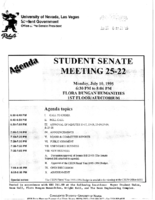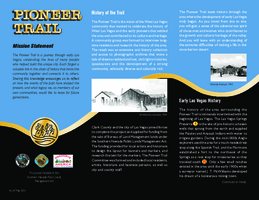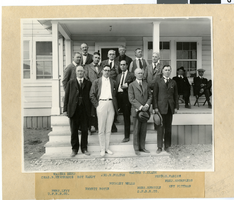Search the Special Collections and Archives Portal
Search Results

Wee Kirk o' the Heather Neon Survey document, August 13, 2017
Date
Archival Collection
Description
Information about the Wee Kirk o' the Heather sign that sits at 231 S Las Vegas Blvd.
Site address: 231 S Las Vegas Blvd
Sign owner: Wee Kirk Property Group LLC
Sign details: Wee Kirk O' the Heather is one of the oldest standing Wedding Chapels to still remain in operation to this day. The building was originally constructed in 1925. Two wedding chapels Wee Kirk O' the Heather and the Hitching Post both opened in 1940 across the street from each other though the Hitching Post has been torn down. Wee Kirk O' the Heather is Scottish themed where the name translates to "Little Chapel of the Lucky Flowers." Since the chapel is considered as one of the oldest wedding chapels here in Vegas, there are quite a few wedding renewals or generational marriages. The site has been featured in multiple Las Vegas films; such as "Fools Rush In, "Intolerable Cruelty," and many more.
Sign condition: 4.5 - The sign is well maintained, no damage is seen.
Sign form: Pylon
Sign-specific description: The current sign is circa mid-2000s. It is mainly a white plastic backlit sign that states "Wee Kirk o the Heather" in a violet swirled font. There is a yellow reader board underneath this. Below the reader board is a small 'Open" sign that contain incandescent light bulbs. Above the logo is a neon rendering of a flower in skeletal neon. The original sign and establishments color scheme was dark blue, mustard yellow and pure white. The protruding cantilever construction is a beautiful decorative white leaf and floral bouquet with a mustard yellow vase. On the bottom is a dark blue faux wood, zig zagged at both ends of the structure and features traditional Gothic font in white. Connected to the faux wood structure is the hanging sign held by two poles with a sign that says "Wedding Chapel; Everything Arranged."
Sign - type of display: Neon, incandescent light bulbs and plastic back lit portion.
Sign - media: Steel and Plastic
Sign - non-neon treatments: Reader board and plastic back lit portion
Sign environment: This location is on Las Vegas Blvd. South and Bridger Ave. This is just a few blocks south of Fremont Street. The property is surrounded by the Villa Inn Hotel-Motel and Lloyd D George Courthouse.
Sign - date of installation: Circa Early-2000's
Sign - date of redesign/move: Transition form older sign to current sign in Early-2000's
Sign - thematic influences: The sign beckons to the current trend of minimal square clean designs that is simple, white, purple and yellow with a trim of leaf and floral design at the top rendered in Neon. The flower design is symbolic to the meaning of "Wee Kirk o the Heather" translation into Wedding chapel of Lucky Flowers.
Sign - artistic significance: The theme of both the sign and architectural building is of a small cottage themed chapel with a minimalist sign. The usage of yellow and purple added to the kitsch theme with the added purple wood trimming to the building. The coloring of the building is similar to the colors in their sign.
Survey - research locations: Wee Kirk O the Heather website https://www.weekirk.com/ , UNLV archives, and Vintage Vegas http://vintagelasvegas.com/search/wee+kirk+of+the+heather , viewing the sign in person, and speaking to a representative on their website.
Surveyor: Gisselle Tipp
Survey - date completed: 2017-08-13
Sign keywords: Pylon; Neon; Incandescent; Plastic; Backlit; Steel; Reader board
Text

Meeting minutes for Consolidated Student Senate University of Nevada, Las Vegas, July 10, 1995
Date
Archival Collection
Description
Text

Transcript of interview with Rachel Gibson by Kay Long & Caryll Batt Dziedziak, August 25, 1998
Date
Archival Collection
Description
Rachel Gibson was the granddaughter of Nevada pioneers. Her maternal grandparents, George Rammelkamp and Anna Dougherty, were among the earliest white residents of northern Nevada, settling first in Dayton and later Yerington. Her mother, Clara Angelina, and her two aunts, Elizabeth and Georgie, graduated from the University of Nevada at the turn of the century. Clara taught in Yerington for a number of years before marrying Chase Masterson, a dentist. Rachel was born in 1913 in Yerington. The eldest of three children, she continued the tradition of women’s learning and education that began with her mother’s generation. Her 1930 class was the first to graduate from Las Vegas High School, and soon after Rachel moved to California to attend college. Although her father had counseled her to study law, Rachel chose the field of economics. She received her Bachelor’s degree from the University of California at Berkeley, and worked in San Francisco for one year before returning to complete
Text

Brochure, Pioneer Trail of West Las Vegas community
Date
Archival Collection
Description
Brochure highlights and maps historic points of interest in West Las Vegas.
Text
Ham, Artemus W., Sr., 1892-1970
Artemus W. “Art” Ham Sr. (1892-1970) was a highly respected Las Vegas, Nevada attorney and a philanthropist who devoted his work towards the Las Vegas community as well as the development of the Las Vegas strip. Ham was also president of the Las Vegas Chamber of Commerce in 1929 and a recognized supporter to the University of Las Vegas, Nevada (UNLV). He became active in the city’s real estate and had faith in the future of Las Vegas.
Person
Hoggard, Mabel, 1905-1989
Mabel Hoggard was the first licensed African-American educator in Nevada. Hoggard taught primarily first and second grade at various elementary schools throughout Clark County, Nevada from 1946 until her retirement in 1970. The schools she taught at included Westside Elementary, Matt Kelly Elementary, Highland Elementary, and C.V.T. Gilbert Elementary, all located in Las Vegas, Nevada.
Person

Photograph of Key Pittman with Nevada politicians and southwestern railroad and mining magnates, late 1910s-early 1920s
Date
Archival Collection
Description
Image
Albert S. Henderson Photograph Collection
Identifier
Abstract
The Albert S. Henderson Photograph Collection (1860s-1959) primarily contains black-and-white photographic prints of Albert S. Henderson and his family. Also included in the collection are photographic prints of Henderson during his tenure as a Nevada legislator and district judge. Other materials include postcards, negatives, and a tintype.
Archival Collection
William J. Moore Jr. Photograph Collection
Identifier
Abstract
The William J. Moore Jr. Photograph Collection (approximately 1942-1960) consists of black-and-white photographic prints, negatives, and one oversize image depicting William "Bill" J. Moore Jr.'s career as a casino operator in Las Vegas, Nevada. Images include events at the Moore family home and the Hotel Last Frontier. Also included are images of Moore with politicians, casino operators, and other notable figures in Las Vegas.
Archival Collection

